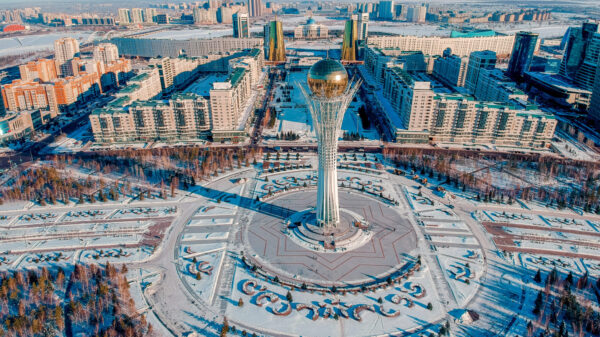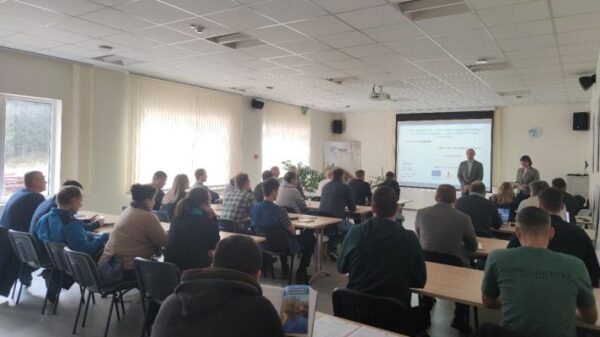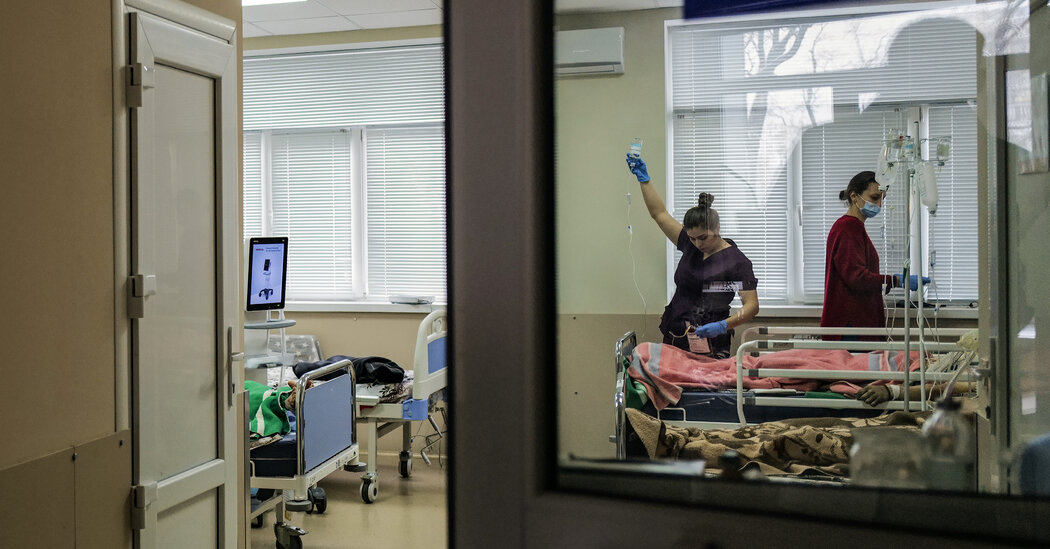As Russian bombings have grown more indiscriminate, hospitals in Ukraine have become perilous places to work.
KYIV, Ukraine — A grim scene awaited Dr. Oleksandr Sherbina as he made the rounds of Clinical Hospital No. 7, a medical facility that once specialized in treating strokes but is now suddenly immersed in the atrocities of war. As he passed the operating theater, surgeons were amputating the lower leg of a wounded Ukrainian soldier.
The hospital is near a combat zone in a northwestern suburb of Kyiv, where the booms of incoming artillery can be heard inside the building amid a scramble of activity as triage nurses greet the ambulances arriving every few minutes. In a hallway, an orderly used a rag to wash blood off stretchers.
“The flow of wounded is growing,” said Dr. Sherbina, a surgeon who is the hospital’s director.
In recent days the fighting between Russian and Ukrainian forces has crept from outlying towns to the edge of Kyiv, and closer to his hospital. “We work and we understand that every day it is getting worse and worse,” he added.
This worries Dr. Sherbina deeply. Even as he and fellow doctors treat patients ravaged by the shrapnel that whistles off mortars and artillery shells, they know they are at risk of suffering the same type of wounds.
“This is what I am most afraid of, because we are close to the fighting,” he said. “I am hoping that the walls defend us.”
Around Ukraine, as Russian bombings have grown more indiscriminate and more civilians find themselves in harm’s way, hospitals have become increasingly perilous places to work. They have been hit by heavy artillery, and doctors and nurses have been killed while performing their duties. The Ukrainian Ministry of Health reported that 34 medical facilities had been damaged and that at least 10 doctors had been killed.
Ambulance workers have also been killed. The ministry said seven ambulances had been fired on, killing four emergency medical technicians in separate incidents, and that another two emergency medical technicians were killed while traveling in civilian cars to treat the wounded.
The ministry’s reports could not be independently confirmed.
The most dire conditions are not in Kyiv, the capital, but in cities partially or wholly surrounded, such as Kharkiv in eastern Ukraine, where three medical facilities have been damaged by artillery: the Kharkiv City Hospital, the Regional Children’s Hospital and a blood bank.
A surgeon working in the military hospital in Kharkiv, who said military rules prohibited her from speaking publicly, described a flood of civilian and military casualties. The hospital, she said, receives 60 to 80 wounded people per day.
“It comes in waves,” she said in a telephone interview. Typically, she said, “the first half a day can be calm and then a huge wave of wounded arrive” later in the day, following the rhythm of the fighting, which tends to take place in the afternoon.
Yevheniy Ilin, a surgical oncologist, was working in the city’s oncology hospital on Feb. 28 when a bomb landed nearby, blowing in all the windows on one side of the building, he said in a telephone interview. The heat and electricity went out in the hospital, he said, so he moved to the city’s military hospital. Many other doctors gave up working in the city and joined the flow of displaced people headed west.
“We are coping,” he said. “You just go and sleep any free moment you have. Whether it is 15 or 30 minutes. You never know when the next shelling will be and if you’ll get to sleep at night.”
The World Health Organization on Tuesday said it had confirmed attacks on medical facilities in Ukraine and said it was investigating reports of more attacks, but the group had a different total than the Ukrainian Ministry of Health. The W.H.O. said it had confirmed 16 attacks on hospitals, in which nine people were killed and 16 wounded, Catherine Smallwood, senior emergency officer for W.H.O. Europe, told a news conference.
The group noted that there had been direct attacks on hospitals and that combatants had at times appropriated ambulances or diverted them for nonmedical uses. The number of attacks had increased rapidly in recent days, she said.
The W.H.O. said it had dispatched 76 tons of emergency medical supplies to Ukraine but that some life-saving items, such as oxygen, insulin and surgical supplies, were in short supply because of the war’s disruptions.
The dwindling supply of oxygen is particularly worrisome, said Dr. Hans Kluge, the W.H.O.’s Europe director. He noted that deaths from Covid-19 in Ukraine, where only about 30 percent of people over 60 are vaccinated, are likely to rise because of oxygen shortages.
Dr. Sherbina’s hospital in Kyiv is now nearly wholly focused on treating those wounded in the fighting. The doctors and nurses have been living in the hospital’s basement since the war began on Feb. 24. They have also set up two backup emergency rooms in the basement and placed cots so they can move patients underground if needed. They have a generator and diesel fuel that will last several days.
Yaroslav Linko, an orthopedic surgeon, said the onslaught of patients began about five days ago, when the Russian army began pushing through outlying towns toward Kyiv. Soon, the wounded started showing up in droves.
Russia-Ukraine War: Key Things to Know
Russian oil imports. President Biden banned Russian oil, natural gas and coal imports into the United States. The move, which effectively shuts off the relatively small flow of Russian fuel into the country, could further rattle global energy markets and raise gas prices.
“When the young nurses see the wounded soldiers, they cry,” said Dr. Pavel Oblap, an anesthesiologist.
Dr. Oblap, a strapping man in scrubs with buzz-cut gray hair, had once treated firefighters for radiation exposure during the Chernobyl nuclear disaster. “It’s exactly the same feeling of catastrophe and sense of alarm,” he said. “But I’ve been working in emergency rooms for 40 years. I’m prepared.”
He said many doctors had left Kyiv as the war started, including some who worried for their children and evacuated to Ukraine’s western regions or left the country. “Only those who are not afraid remained,” he said.
Dr. Oblap was tending to a soldier coming out of surgery for a deep laceration on his left hand. The soldier was lying on a stretcher, groggy and mumbling.
At one point, the soldier, who seemed unable to explain how he had been wounded, tried to stand up and pulled on a drip line in agitation.
Once Dr. Oblap coaxed him back onto the stretcher, the soldier, who offered only his first name, Dmytro, said he wanted to tell a joke. “Putin died and went to hell, but there was a bar in hell,” Dmytro began, referring to Russian President Vladimir V. Putin. But then his head tipped back on the stretcher and he passed out before getting to the punchline.
Talk of the war, and the potential fate of Kyiv, was pervasive. Dr. Oblap said he didn’t expect the Russians to try to capture the capital in street fighting. It would be too costly for their army, he said.
But another doctor standing nearby, Vladimir Novikov, an orthopedist, disagreed. “They will do it and they don’t care,” he said.
Outside, flurries of wet snow blew through Kyiv, blanketing the streets and covering the hoods and hats of people standing in long lines for grocery stores. At Clinical Hospital No. 7, as more ambulances arrived, Dr. Sherbina said he is ready to keep working even if the fighting moves into the nearby streets.
“We will do the maximum,” he said. “As much as is needed, we will do.”
Maria Varenikova contributed reporting from Lviv, Ukraine, and Nick Cumming-Bruce from Geneva.


























